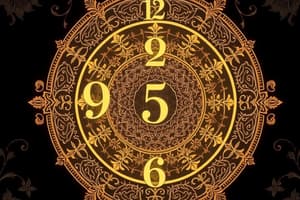Podcast
Questions and Answers
Which type of number represents parts of a whole?
Which type of number represents parts of a whole?
- Decimals
- Prime numbers
- Integers
- Fractions (correct)
Which type of number usually has a decimal point and involves powers of ten?
Which type of number usually has a decimal point and involves powers of ten?
- Decimals (correct)
- Prime numbers
- Integers
- Fractions
What type of numbers include both positive and negative values?
What type of numbers include both positive and negative values?
- Decimals
- Integers (correct)
- Prime numbers
- Fractions
Which set of numbers are those that cannot be divided evenly by any other number except themselves and one?
Which set of numbers are those that cannot be divided evenly by any other number except themselves and one?
What is the representation of one-half?
What is the representation of one-half?
Which of the following is a Roman numeral representation of a positive integer?
Which of the following is a Roman numeral representation of a positive integer?
What is the unique way in which every integer greater than one can be expressed?
What is the unique way in which every integer greater than one can be expressed?
Why is division by zero generally considered undefined?
Why is division by zero generally considered undefined?
Which arithmetic operation is affected when the divisor is less than the dividend?
Which arithmetic operation is affected when the divisor is less than the dividend?
What is the result of multiplying two numbers?
What is the result of multiplying two numbers?
Which mathematical concept is essential when dealing with algebra, geometry, and calculus?
Which mathematical concept is essential when dealing with algebra, geometry, and calculus?
What property is violated when subtracting a larger number from a smaller number?
What property is violated when subtracting a larger number from a smaller number?
Flashcards are hidden until you start studying
Study Notes
Number System Overview
The number system is a fundamental concept in mathematics used for counting, measuring, and performing calculations. It consists of numerical symbols and rules that allow us to represent quantities and perform arithmetic operations. Here, we will explore different parts of the number system, specifically looking into integers, fractions, decimals, and prime numbers, along with their respective operations.
Integers
Integers are whole numbers including both positive and negative values. They can be represented by Arabic numerals such as +1, -2, 8 etc., or Roman numerals like II, III. Negative integers have a minus sign (-) preceding them, while positive integers don't require any special notation.
Fractions
Fractions represent parts of a whole. For example, half is written as ½ or \frac{1}{2}, which means one out of two equal parts. A fraction has a numerator and a denominator separated by a slash. The value of the fraction depends on the relationship between its numerator and denominator.
Decimals
Decimals are fractions where the denominator is a power of ten, usually expressed using a decimal point. For instance, 0.75 means three-quarters, or seven out of every ten parts.
Prime Numbers
Prime numbers are those that cannot be divided evenly by any other number except themselves and one. For example, 2, 3, 5, and 7 are all prime numbers. Every integer greater than one can be expressed as either a product of primes or a single prime itself.
Operations with Numbers
Arithmetic operations involving addition, subtraction, multiplication, and division can be performed on these types of numbers. These operations follow specific rules and properties that help make mathematical calculations efficient and accurate.
For example, when adding or multiplying two numbers, you simply add or multiply their corresponding digits respectively. However, when dividing or subtracting, care must be taken to ensure that the result is meaningful. Division by zero is generally considered undefined because it would imply the existence of a quantity larger than any real number. Similarly, if the divisor is less than the dividend, the result of subtraction ends up being smaller than the dividend which does not make sense mathematically.
Understanding these basic principles allows us to navigate through various branches of math such as algebra, geometry, calculus, and more complex topics like number theory and cryptography.
Studying That Suits You
Use AI to generate personalized quizzes and flashcards to suit your learning preferences.




